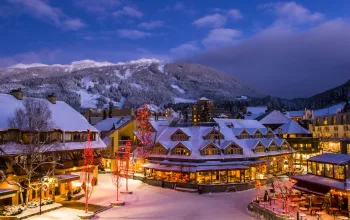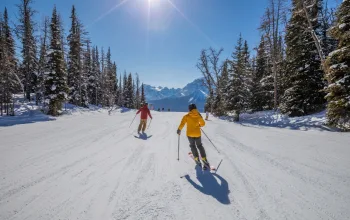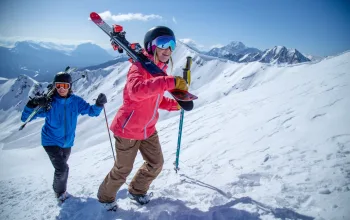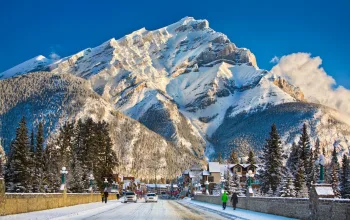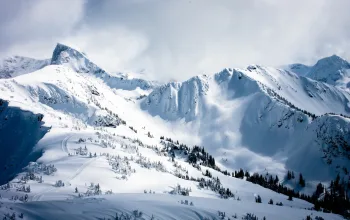The biggest night-skiing vertical in Canada ( 625 M ), located thirty minutes ( 25 miles ) from historic Québec City with it's rich range of facilities. Mont - Sainte - Anne also boasts the largest cross-country ski centre in Canada and a wonderful backdrop of the St Lawrence River. The resort is host to many international competitions in Alpine skiing, snowboarding and mountain biking.
Mountain
Mont-Sainte-Anne has a vast skiing area with slopes ranging from gentle beginner areas to the double black diamond runs which have attracted so many of the World Cup events. Spread over three sides of the mountain, the 60+ ski and snowboard trails cover 450 acres and 68km/42miles. Thirteen modern lifts , thats an eight-passenger gondola, three quad chairs, one triple, two double chairs and six ground lifts with an uplift capacity of 18,560 skiers per hour ensuring that lift lines are a rarity here. Abundant natural snowfall 400cm/160inches average per year and huge investments into snow grooming and snow making guarantee excellent snow conditions from mid November to late April and, not surprisingly, this resort is renowned for its excellent trail conditions. Mont-Sainte-Anne's state of the art ticketing system allows you to ski at both there and Stoneham on the same lift ticket (carte blanche) and beginner skiers and boarders have free access to two nursery slopes. Nordic skiing is as big as the alpine discipline in Québec and Mont-Sainte-Anne is Canada's biggest cross-country area with 212km of groomed trails and 125km of trails for skating stride. Beginners have the choice of seven green trails representing 29% of the network. These trails range from three to 13km, allowing each individual to choose the run corresponding to his or her capacity. For those in search of a greater challenge, the blue trails (40% of the trail network) offer hours of skiing delight with trails ranging from five to 24km. Expert skiers will also find more demanding, steeper trails to challenge their technical skills within the black diamond trail network. The resot's Cross Country Ski Centre has a range of services including ski boutique with rental and repair services, a spacious waxing room, 8 heated shelters, restaurant and ski school. For night skiing there are 17 floodlit slopes with a total length of 15km and these are open 4nights a week, from Tuesday to Saturday until 10pm (offered seven nights a week during busy periods). During night skiing the IZI Cafe Lounge and the Chouette Bar are open for food and refreshments.
Families
The Children Centre at Mont Sainte Anne can accommodate up to 200 children. Babies from 6 months up to 18 months can join the nursery where facilities include high chairs and a room with cots for children to nap. Qualified staff have a programme of indoor and outdoor activities to keep children amused, from puppet shows, arts and crafts, movies and dressing-up to sliding, skating, sleigh rides and obstacle races. Their Kinderski Programme is like a winter camp and childrens ski lessons are designed to be fun where learning is presented as a game. Instructors at Mont Saint Anne seem to have perfected the art of playing on snow so that kids not only learn to ski but learn to like it as well.
Eating Out
A wide range of dining options on the mountain as well as in the Mont St Anne vicinity, in fact some of the best restaurants in Québec are in this area. People in Québec not only know how to enjoy themselves, they know how to eat well. Fine restaurants with gastronomic menus abound and even in smaller establishments you'll find an attention to quality and detail that makes eating out a delight. Eating out in Québec City is enhanced by the ambience of 17th and 18th century dining rooms in the Old City, while down in the narrow cobblestone streets of the old port area, you'll find any number of cosy inexpensive family-run bistros with seafood to die for. The robust cuisine of Québec's early pioneering days is served in country establishments such as sugar shacks (the old name for maple syrup factories). A typical menu will include pea soup, pork and beans, maple-smoked bacon or ham, eggs or omelette and crepes with lashings of maple syrup. In the Saguenay-Lac-St-Jean area, nothing beats the tast of fresh blueberries served at breakfast or in delicious desserts at lunch and dinner. Other regional specialities are game and seafood, lamb in Charlevoix and goose in Montmagny. Lobster and cod are especially good in Gaspesie. Local wines are produced in the Eastern Townships and Montérégie regions, while imported wines are freely available everywhere. A deeply rooted French heritage is one reason why cheese is a major industry in Québec. Around 50 factories produce more than 100 delicious varieties. Loyalist settlers also brought their skills, which is why Canadian cheddar is one of the most celebrated varieties. When Trappist monks settled in the Oka region, they continued making the cheese known in France as Port Salut. The easter Townships, Montérégie, Lac St-Jean, Charlevoix and Chaudiere Appalaches regions are especially known for their wonderful scenery and delicious cheeses.
Apres
The Québecois love of the outdoors is matched by their fondness for the good things in life. In the cities when the sun goes down, the lights come on in sidewalk cafes, jazz clubs, comedy clubs, cabarets and theatres. A traditional night out would be a visit to a "sugar shack" (cabanes a sucre) where maple syrup is produced. The aboriginal Indians taught the first colonists how to collect the watery maple sap and boil it down to obtain a rich, golden syrup prized for its colour and flavour. That ritual spawned a booming industry which now accounts for 85% of all the maple syrup, maple taffy and maple sugar produced in Canada. Everyone's avourite, maple taffy, is made by pouring a ribbon of hot syrup on a bed of clean snow; as the syrup begins to harden, you wrap it around a little wooden stick and you have a maple taffy. March and early-April, when the sap begins to rise is when everyone heads for the sugar shacks and big wooden tables groan with maple-based desserts. Traditional rural music generally accompanies the country-style feast and of course the transport is by horse-drawn sleigh. Mont-Sainte-Anne has very its own sugar shack located in the trail La Pichard at mid-mountain elevation. Another tradition handed down by the indigenous peoples and currently practised just about everywhere in Québec is ice-fishing. As soon as the ice is thick enough, colourful little wooden shacks are dragged out onto frozen lakes and rivers. The shacks, which are usually rented, provide varying degrees of comfort but basically they offer shelter from the wind and allow ice-fishers to extend their time outdoors. Ice fishing is now newly offered at Mont-Sainte-Anne at its base.
Boarding
Instead of separating skiing and boarding, Mont-Sainte-Anne was one of the first resorts to decide to open their kilometre (282,500-sq.ft. (26,250 sq.m.) long terrain park to both skiers and boarders. The Grande Allée was chosen as a site for the terrain park for its accessibility and being under a chairlift adds to the spectacular side of freestyling! The name Grande Allée comes from a street in Québec known for its many bars and restaurants. In 1997 the resort invested in a Pipe Dragon, the implement which attaches to the snow groomer and can carve the most perfectly shaped, smooth half-pipe as well as building and carving tabletops and up turns. Starting off with an 80m long halfpipe, the park has jumps at various heights, the "freecarve" slalom course, a series of small rolls or absorption jumps and several table tops of varying heights. Boarders can jump from the front or the side on these tabletops offering the choice of big air, long jumps or tricks. The up-turns help to gather speed for entry into the quarter-pipes and then the park ends with a big roll, 2 big jumps and a last jump over the waves. This is an all-round park which can even be integrated into boardercross when four to six boarders race, all at the same time, down a course. Over the years Mont-Sainte-Anne has hosted many World Championships including the FIS Snowboard World Cup in 1997. The making of the World Cup halfpipe took five days of work from the grooming machine to roughly shape it then a day with the Pipe Dragon for the finishing touches. To comply with World Cup rules the halfpipe had to be 100m long, with 3m walls 16 m apart.




